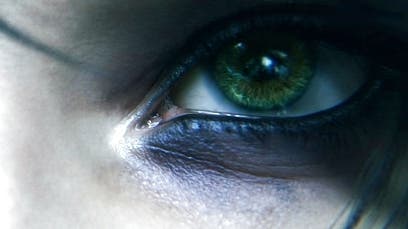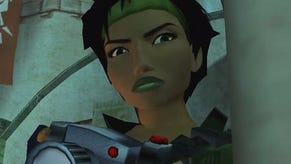The good, the unknown and the ugly of Beyond Good & Evil 2
Turn the Pey'j.
Last week, Beyond Good & Evil 2 creator Michel Ancel told fans to expect a playable beta of the game towards the end of 2019. It was disappointing news, perhaps, for those eager to explore the kind of worlds glimpsed in last year's flashy E3 debut trailer. But it was also news which should come as absolutely no surprise to anyone following the game's still-early progress.
What sort of game will Beyond Good & Evil 2 be? It's still hard to say - a year on from the tech demo shown behind closed doors at E3 2017. Over the 12 months, Ubisoft Montpellier has periodically streamed updates to its loyal followers on Twitch, but these have mostly just been opportunities to share concept art and answer questions. For this year's E3, Ubisoft Montpellier packed a proper gameplay demo in its suitcase, one which showed off co-op play and some early combat and exploration systems - but it was another glimpse which left us with probably more questions than answers.
I'm excited for Beyond Good & Evil 2's story after hearing how the dots connect between the two flashy CGI trailers shown thus far. Likewise, I'm delighted by this year's confirmation BG&E1 stars Jade and Pey'J are back for definite. For those in need of a recap, last year's trailer saw our crew of heroes steal a set of coordinates and set off for something named Moksha's Gate, a mysterious object described by Ubisoft Montpellier as "a door in space", led by a captain who shared a familial resemblance to Jade. This year, we caught up with the crew later on, with the captain mysteriously missing, as Jade herself pops up as an antagonist and seemingly ends the mission to Moksha's Gate for good.
In a presentation to Eurogamer and other assembled press given behind closed doors, Ubisoft Montpellier described Jade's surprising new appearance as that of a pirate hunter. The studio also confirmed that all of the above acts as setup to the actual game, which takes place "years later", and where you play as your own space captain. Your story is about getting that old crew of heroes back together to find out what's going on, what actually lies behind Moksha's Gate, and - presumably - ensure Jade returns to the good side.
It's clear a lot of thought has gone into the game's worldbuilding. Our presentation began with yet more backstory, and what works as a clever in-universe explanation for BG&E2's character creator. You can play as any combination of any in-game animal race, as the humans in the game's world - left sterile after years of space travel from Earth - have begun making such hybrids themselves. (And I love and very much plan to embrace the fact I can play the game as a half-monkey, half-pig.)
There's a darker side here, too. Many of these clones were created for a specific purpose - to be workers: mechanics, miners. Soma, the planet which houses the game's demo area of Ganesha City, is permanently geolocked to its star. Its rich inhabitants live on the permanently sunny side while the slave class of clones toil away on the dangerous and dark always-night side, bombarded by valuable meteorites from space. I was pleased to hear that Ubisoft Montpellier is planning to explore this theme - that being created from clone DNA yourself you come from a class of people treated differently, seeking equality and freedom from a ruling class which uses the myths and legends surrounding the game's religion to keep slaves obedient.
Our demo begins in a dungeon-like area underneath that hulking statue of Ganesha seen last year, as two players investigate a group of evil scientists carving up hybrid slave corpses for experimentation. Grisly piles of body parts lie around the fairly functional-looking environments as we swoop in and kill off the scientists. "Clones are treated as subclass citizens," senior producer Guillaume Brunier says. "Once finished they are put out to trash. If you didn't escape your fate and become a space pirate, you could have ended up in those crates." After a fairly one-sided firefight, a surviving monkey clone who didn't get dissected can be recruited to our crew - a mechanic key to the game's progression system, but one which is being kept under wraps until later.
Combat in the original BG&E was focused on melee attacks, which return here via a pirate sword. A placeholder HUD marks out your character's health, armour and remaining bullets. Combat looks functional, with augments for weapons to give them extra powers like the ability to slow enemies or add a knock-back effect to your attacks. You can wield a gun, sword or energy shield. Augments can be applied to any of your equipped items, including your jetpack - it'll be interesting to see how that works. I liked the spyglass item shown, an upgraded version of the camera from BG&E1, which can now tell you an NPC's faction, enemy type, and whether they have augmented weapons themselves. These modifiers - the same ones you can have too - will vary combat even when fighting the same enemy types, Ubisoft said.
After the dazzling visuals and story-based moments of the CGI trailers, it's a much smaller scale, far more basic-looking slice of gameplay to show off. But the scale is raised as we escape the dungeon, head out into the overworld and climb aboard a hoverbike. Ganesha City is there, built, to be flown around and explored. But like the single city in BG&E1, it is currently little more than a backdrop. It remains to be seen how much - if anything - there will be to get out and do on foot. The scale is raised again as we dodge police, a heavily stripped back version of the kind of action shown in the E3 2017 trailer, and jump in our own spaceship, zooming off into the atmosphere and out into planetary orbit. The surface to space gameplay shown last year still looks great, and one nice touch is how the game scales - so you can use your spyglass while in orbit to examine planets and planetary features instead of just the enemies and objects on the ground.
"When you're exploring a temple you have a feeling of adventure. When you're exploring at this level, you have this same level of adventure," Brunier said, pointing to a huge bit of artwork burned into the side of a nearby planet, which is viewable from space. It's a cool thing to spot, but it opens up more questions. With the whole of a planet able to zoom around, what else is there to do away from the couple of landing zones we saw? Is the whole planet there to explore, and what else is there to do? Or if not, as seems likely, what is the point of space-based gameplay, other than a feeling you're zooming around the galaxy instead of quickly hopping between isolated hubs?
The key ingredient, I feel, is that story. It'll be the missions and character moments laid over this galaxy in some way, and the sense of progression and adventure which comes from exploring those. Just a few more drops of that could lift the slightly barren-feeling demo we saw - and I'm sure will do as the game continues along its road to release. Whenever we properly get to see it next - hopefully sooner than another E3, again - I'm hopeful we'll get more answers than questions.








-1-14-screenshot_Laf3S8u.png?width=291&height=164&fit=crop&quality=80&format=jpg&auto=webp)


